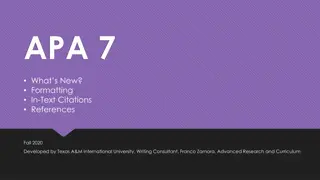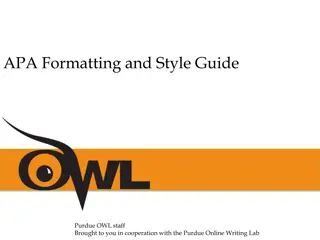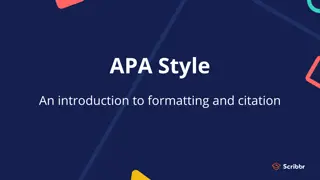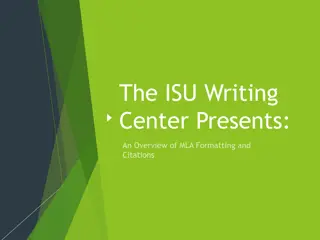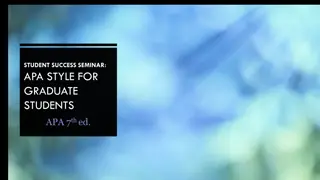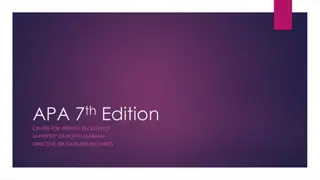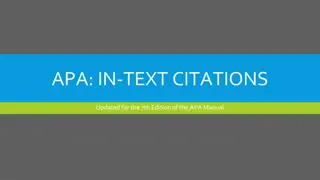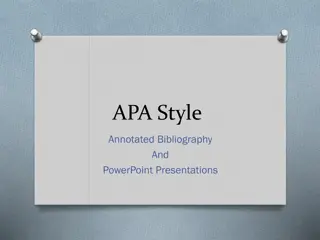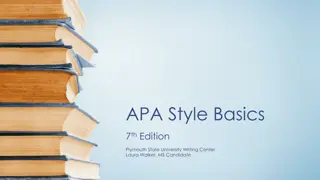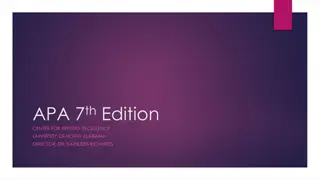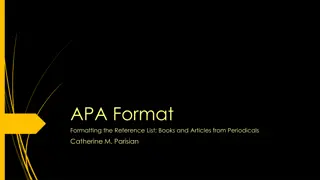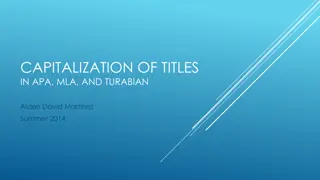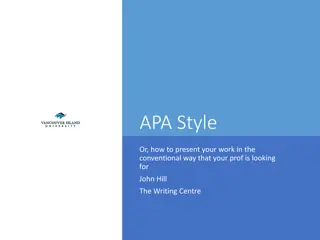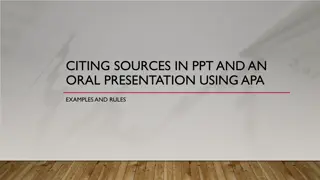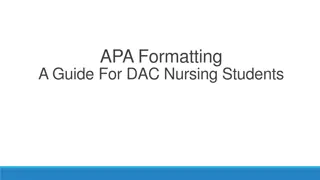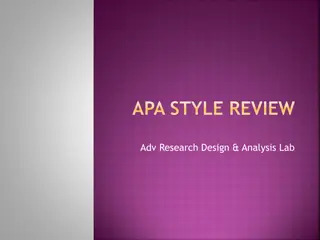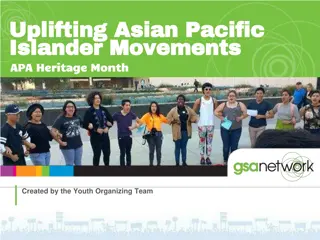Understanding APA Style Essentials
Explore the fundamentals of APA style, covering topics such as the importance of APA, in-text citations, paper formatting, resources for assistance, and the significance of avoiding plagiarism. Learn what an APA paper looks like and the key sections it should include for academic integrity.
Download Presentation

Please find below an Image/Link to download the presentation.
The content on the website is provided AS IS for your information and personal use only. It may not be sold, licensed, or shared on other websites without obtaining consent from the author. Download presentation by click this link. If you encounter any issues during the download, it is possible that the publisher has removed the file from their server.
E N D
Presentation Transcript
APA Made easy(er) January 7, 2019 Preeti Gupton, NAU Librarian
What we will be covering What is APA and why are we using it? What does an APA paper look like? What is an in-text citation, why do you need one, and how do you make one? What resources are available for help? What questions do you still have?
Library Resources NAU Library APA Style Formatting and Style https://national.libguides.com/apa APA references APA in-text citations APA formatting APA videos and tutorials And many more!
WHAT AND WHY? APA = American Psychological Association (NOT Awful Painful Annoying) We use APA format to keep everyone s papers consistent. That makes it easy for your instructors to know what to expect when reading a paper, and offers students the same path for how to format their paper
Why Should I Care? PLAGIARISM Any time you use the words or ideas of someone else to back up your thesis you have to cite it, so that the reader knows what parts of the paper are coming from you and what parts are coming from someone else. If you don t cite correctly, you could be plagiarizing!
What does an APA paper look like? APA calls for: 12 pt Times New Roman font 1 inch margins all around Double-spaced throughout Page header on top left of each page Page numbers on the top right
What does an APA paper look like? Papers typically have four sections: 1) Title Page 2) Abstract 3) Body of Paper 4) References Page Your papers should include each of these sections, unless your instructor has said no abstract necessary.
Title Page No bold font, no italics, no images. Your title page should not look exciting (unless you ve given your paper an exciting title).
Abstract This is a brief summary of your paper, typically about 150 words. Note the word Abstract is not in bold. Or italicized. Or in a different font. Do not just copy and paste your intro paragraph and use that as an abstract.
Body of paper Put the full title of your paper on the first line, centered. Indent the first paragraph of your paper (and subsequent paragraphs). Remember to double space!
Library Tools to Help Zombie Sample Paper APA Formatting in Microsoft Word (PDF) APA Paper Fillable Template
Body of paper: In-Text citations Quoting Using someone else s exact words. Make sure to include a page number. Paraphrasing Rephrasing someone s writing or ideas into your own words. Page number not required but include if it will help your reader locate the relevant information. Summarizing Putting the main idea(s) of someone else s writing into your own words. Page number not required.
Body of paper: In-Text citations Any time you paraphrase, summarize, or quote from an outside source in the body of your paper, you MUST MUST MUST include an in-text citation in the body of your paper to indicate that the information came from someone other than you! If you don t use an in-text citation, your instructor may think you are plagiarizing.
Body of paper: In-Text citations An in-text citation usually provides the author s last name, the year the piece of information was published and, if quoting something, the page number or paragraph number where the quoted information appeared. Author s last name, year, and sometimes a page # or paragraph #.
Body of paper: In-Text citations Narrative - This citation indicates that credit was given to the author and is located within the text itself. Parenthetical - This citation indicates that no author has been given credit within the quote and is located at the end of the quote. Note: Either way is fine to use, as long as you cite correctly! (In-text Citation Quick-guide Reference, n.d.)
Body of paper: In-Text citations Original passage: Paraphrase of original, with in-text citation (where author s name is integrated in the text): The partners Mars and Murrie dubbed their new candy with their initials, and M&M s soon found their way around the world with U.S. servicemen....The story didn t end sweetly for Murrie, though. When chocolate rationing ended after the war, Mars bought out Murrie's 20% interest in the product and went on to become one of Hershey s biggest competitors. In an article about the origins of M&Ms, Soniak says that Mars and Murrie named the new candy after themselves. The candy traveled worldwide during WW2. Murrie s shares in the company were sold to Mars after the war; Mars would later go on to become a major competitor in the chocolate market (2012). Author: Matt Soniak. Title: What do the Ms on M&M s Stand For, and How Do They Get Them on There? Date: 2012 Retrieved from: http://mentalfloss.com/article/30494/what-do- ms-mms-stand-and-how-do-they-get-them- there
Body of paper: In-Text citations Original passage: Paraphrase of original, with in-text citation, where author s name is included in parenthesis: The partners Mars and Murrie dubbed their new candy with their initials, and M&M s soon found their way around the world with U.S. servicemen....The story didn t end sweetly for Murrie, though. When chocolate rationing ended after the war, Mars bought out Murrie's 20% interest in the product and went on to become one of Hershey s biggest competitors. Mars and Murrie named the new candy after themselves. The candy traveled worldwide during WW2. Murrie s shares in the company were sold to Mars after the war; Mars would later go on to become a major competitor in the chocolate market (Soniak, 2012). Author: Matt Soniak. Title: What do the Ms on M&M s Stand For, and How Do They Get Them on There? Date: 2012 Retrieved from: http://mentalfloss.com/article/30494/what-do- ms-mms-stand-and-how-do-they-get-them- there
Body of paper: In-Text citations Original passage: Quote of less than 40 words, with in-text citation: The partners Mars and Murrie dubbed their new candy with their initials, and M&M s soon found their way around the world with U.S. servicemen....The story didn t end sweetly for Murrie, though. When chocolate rationing ended after the war, Mars bought out Murrie's 20% interest in the product and went on to become one of Hershey s biggest competitors. According to Soniak, Mars bought out Murrie s 20% interest in the product and went on to become one of Hershey s biggest competitors (2012, para 4). Could also cite like this: According to one historian, Mars bought out Murrie s 20% interest in the product and went on to become one of Hershey s biggest competitors (Soniak, 2012, para 4). Author: Matt Soniak. Title: What do the Ms on M&M s Stand For, and How Do They Get Them on There? Date: 2012 Retrieved from: http://mentalfloss.com/article/30494/what-do- ms-mms-stand-and-how-do-they-get-them- there
Body of paper: In-Text citations Try to paraphrase or summarize when possible Put the author s ideas in your own words to support your own ideas! Quote only when needed Further advice on this: Writer s Handbook from the Writing Center at the University of Wisconsin-Madison: http://writing.wisc.edu/Handbook/QPA_paraphr ase.html
Body of paper: In-Text citations Quotes of more than 40 words, with in-text citation: http://arc.national.edu/library/docs/Zombies.pdf http://arc.national.edu/library/docs/APA_in-text.pdf
Reference Page Only include items in your References page that you created an-text citation for in the body of your paper. The reference citation gives your reader more thorough publication information than the in-text citation does -- your reader can track down the piece of information on their own if they want to with the info you provide.
Reference Page Should be double-spaced (like the rest of your paper). Should be in alphabetical order, by author s last name. Use a hanging indent for citations that take up more than one line of text.
Reference Page Example Header Hanging indent (Rojas, n.d.).
Reference Page The APA manual provides different patterns for citing items in your reference list, depending on what type of item you are citing. Books, articles, and interviews, for example, are formatted differently.
Reference Page Regardless of what you are citing, you need to find the following for each piece of information you are citing: Author When it was published Title Where it came from
References - Author The author can be a person or a corporate author (aka, a company name). You list the author s last name and initials only. It should be rare that you can t find an author or corporate author. If you can t find an author, you put the title where the author usually goes.
References When it was published In many cases, you ll just need the year an item was published. Some types of sources also require a month and date, if available. If you can t find a publication date, you ll put (n.d.) in the date field. ND=no date
References Title This could be: The title of a book (if citing the whole book) The title of a book chapter (if only citing a chapter) The title of an article The title of a blog post
References Where it came from This could be: The publisher s name and city/state (if citing a book). The book title AND the publisher s name and city/state (if citing a chapter in a book). The title of the journal where the article was published, as well as the volume, issue, and page numbers.
Library Resources APA Reference Page Examples (PDF) In-text Citation Quick Reference Guide (PDF) How to Use the Cite Function in a Database (PDF) Purdue OWL! NAU Librarians!
References LET s put ONE together, together! http://www.smithsonianmag.co m/science-nature/in-search- of-the-mysterious-narwhal- 124904726/
References LET s put ONE together, together! Author: Abigail Tucker. When: May 2009 Title: In search of the mysterious narwhal Where it came from: Smithsonian Magazine What kind of source is it?
References LETs put ONE together, together! Pattern for citing an online website document or webpage: Author, A. A., Author B. B., & Author, C. C. (year, Month day). Title of document. Retrieved from http://magazine.homepage Author: Abigail Tucker. When: May 2009 Title: In search of the mysterious narwhal Where it came from: Smithsonian Magazine
References LETs put ONE together, together! Plug your information into the pattern: Tucker, A. (2009, May). In search of the mysterious narwhal. Retrieved from https://www.smithsonianmag.com. Author: Abigail Tucker. When: May 2009 Title: In search of the mysterious narwhal Where it came from: Smithsonian Magazine
Library Resources APA Reference Page Examples (PDF) In-text Citation Quick Reference Guide (PDF) How to Use the Cite Function in a Database (PDF) Purdue OWL! NAU Librarians!
Extra Credit Proof of attendance is your quiz score! A link to the quiz will be email to you within the hour. Check your spam folder! Email your quiz results when you ge them to your instructor. They may offer extra credit. The library does not.
Questions? You can also contact Ask a Librarian for APA support! askalibrarian@national.libanswers.com We re here to help!!!!!



